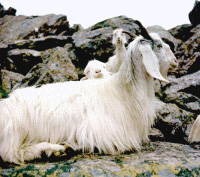

|
|

Yarns and fibers in cashmere

Cashmere
Cashmere (Kashmir)
Introduction
Cashmere the fiber of kings, is a valuable natural fiber and a high-quality material of
the textile industry. It is also eulogized as "fibre diamond" or
"soft gold". Sixty percent of the world's supply of Cashmere is produced in China and the remainder
in Turkey, Afghanistan, Iraq, Iran, Kashmir, Australia and New Zealand.
Cashmere goats are easy to raise. They can survive on bushes, trees, desert scrub and aromatic herbs when sheep and cattle would starve to death.
They are healthy animals and take only minimal care and are sheared once a year
- a full grown adult will yield as much as 2&1/2 pounds of fleece. The fleece consists of two kinds of fiber, Cashmere which accounts for up to 60% and guard hair the
rest. The fleece then is dehaired and called dehaired goatswool

To keep out cold during winter times there appears a kind of fine and thick
under fur on
the goats body. The colder it is, the thicker, finer and longer the under fur becomes.
The coarse wool taken from goats will undergo the process of
selecting, washing and combing, so the coarse hair, skin scraps, oil and other contents are excluded
- this final product is called cashmere. Its fineness is 7-19 microns with average fineness about 14
microns. Cashmere fibre is light, soft, smooth, resilient, moisture-absorbing and
is keeping warm. Its luster is natural and soft. The annual output in China is 9,000-10,000
tons. The best cashmere comes from the grassland of Inner Mongolia autonomous region of
China.
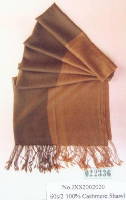 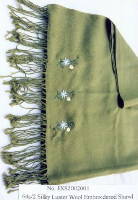
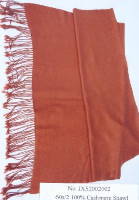
Properties
Fibre is cylindrical, soft and silken. More like wool than any other hair fibre. Has a very soft silky finish; very light in weight. Doesn't stand up to hard wear on account of extremely soft downy finish. Natural fibre is white, black, brown or gray but can be died a variety of shades. Comes in different weights.

| Applications
Cashmere can be made into various kinds of products like
- - scarves
- - shawls
- - sweaters
- - hats
- - underwear
- - apparel
- - socks
- - quilts
etc

-
Cautions for wearing
In order to avoid the pilling caused by local friction, the lining of the outerwear must be slippery when the cashmere garment is worn inside. Never load pen booklet wallet and other hard material in the pocket.
When the cashmere garment is worn outside, you should minimize the friction between the cashmere garment and hard things (for example; the friction between the cuff and desk surface the cuff and the armrest of sofa? back part and sofa etc.).
In order to avoid the fiber fatigue and recover its elasticity, the cashmere garment is not suitable for long term of wearing and about ten days of interval is needed.
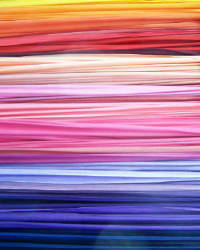
-
Cautions for washing
1. Under the normal conditions, hand-washing is acceptable.
2. Firstly measure the chest size body length and cuff length and make a record of it before washing, then turnover the cashmere garments and check if it is severely contaminated. Make a mark if contamination occurs.
3.Put the special cleaning agent into the water of 35 degree C
for mixing, and then put the cashmere garments in the mixed water for soaking for 15-30 minutes. High density of washing detergent is used when adopting the way of pressing and squeezing for washing the cuff and collar and other heavily contaminated spot and slightly patting other parts of the garment. If the cashmere garment is contaminated with coffee juice blood and other material, you should send it to the special laundry for washing.
4. In order to avoid colour mixing, jacquard and multi-colour cashmere garments are not suitable for soaking, and so it is with the different colour of cashmere garments.
5.After the washing is finished, rinsing the cashmere garments with 30 degree of centigrade water. Hand feeling will be better when you put the outfitted softening agent into the rinsing water in accordance with the instruction.
6. Squeezing out the washed cashmere garment, and then put it into the detraction cone of washing machine for detracting.
7. Flat the detracted cashmere garments on the table which is covered with towel blanket and measured it to its original size with ruler, and then put it to its prototype with hands for drying in the shade. Never hang it for direct sunlight.
8. After drying in the shade, you can iron it with steaming flatiron (about 140 degree
C), the flatiron should keep the distance of 0.5-1cm from the cashmere garment, never press it directly on the cashmere garment, if you use other type of flatiron for ironing, a wet towel must be padded under it.

-
Cautions for collection
In order to avoid the deformation of its drapability, the cashmere garment must be washed and dried clean before collection, then folded and put into the plastic bag. Never hang it, and mix it with other material in the same bag. It must be stored in good ventilation no sunlight and dry places. Direct contact must be avoided between moth-eaten proof agent and the stored cashmere garment.
|
Grades
- fibers
- tow/tops
- spun yarns
|
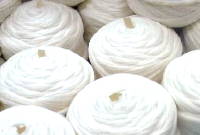 |
| Processability
CASHMERE PRODUCTION AND DISTRIBUTION
Cashmere is the fine fiber that comes from the soft undercoat or under layer of hair of a goat.
It is an extremely rare fiber and is available in limited supply. One goat yields an average of four to six ounces of fiber. It takes 32 ounces of fiber to make one sports jacket and 10 to 12 ounces of fiber to make one two-ply sweater.
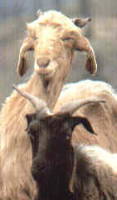
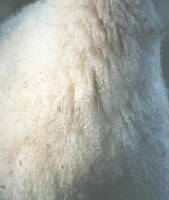 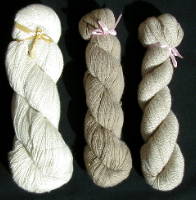
There are following steps in cashmere production:
- Collecting
Cashmere fibers are collected by either combing or shearing the animal during the molting season. Goats molt during a several week period in the spring.
- Sorting/Scouring
Hand sorting for coarse hair takes place. After sorting, the fiber is washed to remove dirt, grease and any vegetable matter gathered in the collection process.
- Dehairing
The scoured material is then dehaired. This step removes vegetable matter, dandruff and the coarse outer guard hair. At the end of this process, the cashmere is ready to be spun into yarns for weaving and knitting, the fourth and fifth steps.
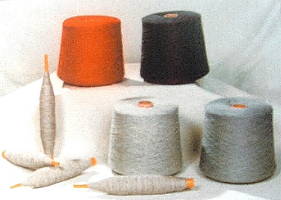
 |
| Background
information
There are three basic kinds of goat fibre….The history of fibre producing goats is long, probably dating back as far as 9,000 BC and probably where Turkey is on today’s map of the world. Research indicates that the Bezoar Wild Goat (Capra aegagrus) was the main ancestor of the domestic goat (Capra hircus) which spread across the Old World to
China
|
| Our
supplier partner
Hebei Founder is a state-owned company
in China with a history of nearly 30 years in the line of import and export
animal by-products.

|
|
|



